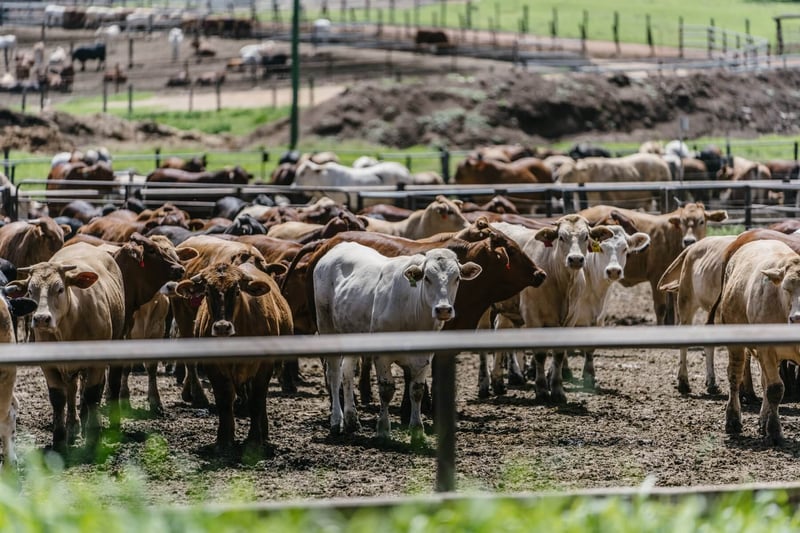Master the Art of Cooking With Yard Fed Meat
In the realm of culinary experience, grasping the art of food preparation with grass-fed meat holds a distinguished setting. From the tender appearance to the durable flavor profile, grass-fed meat provides a canvas for cooking creative thinking.
Advantages of Grass-Fed Meat

When choosing grass-fed meat, consumers can benefit from its higher levels of omega-3 fatty acids and antioxidants compared to conventionally increased meat. Constance Cattle. Omega-3 fatty acids are necessary nutrients that sustain mind wellness, minimize swelling, and advertise heart health and wellness. Grass-fed meat is understood to have up to five times a lot more omega-3 fats than grain-fed meat, making it a healthier option for those wanting to enhance their intake of these useful fats
Along with omega-3 fatty acids, grass-fed meat is also richer in antioxidants such as vitamins E and C, in addition to beta-carotene. Anti-oxidants play a critical duty in securing cells from damage triggered by totally free radicals, which can contribute to numerous persistent illness and accelerate aging. By selecting grass-fed meat, customers can not only enjoy a more nutrient-dense and delicious protein source yet likewise support their total health and well-being.
Including grass-fed meat into your diet can be a straightforward yet reliable way to boost your dietary intake and gain the benefits of omega-3 fats and antioxidants that are naturally bountiful in this kind of meat.
Ideal Cooking Methods
Making use of suitable food preparation techniques is vital to preserve the nutrient account and improve the taste of grass-fed meat. When cooking grass-fed meat, it is essential to keep in mind that it is leaner than traditionally raised meat, making it a lot more prone to drying out if overcooked. To ensure a juicy and delicious end result, consider cooking grass-fed meat at slightly reduced temperatures than you would certainly with grain-fed meat.
Grilling is a prominent approach for cooking grass-fed meat as it enables excess fat to trickle away, preventing flare-ups that can cause charring. When barbecuing grass-fed meat, usage tool warm and maintain a close eye on it to stop overcooking. One more great food preparation method for grass-fed meat is pan-searing. This technique aids secure in the juices and create a tasty crust on the meat.
Sluggish food preparation strategies such as braising or cooking are also outstanding choices for tougher cuts of grass-fed meat, as they assist break down the muscular tissue fibers and soften the meat. Whichever food preparation approach you choose, remember to let grass-fed meat rest after cooking to enable the juices go to this web-site to rearrange, guaranteeing a damp and tender final meal.
Flavor Pairings and Seasonings
To improve the all-natural tastes of grass-fed meat, calculated taste pairings and spices play a crucial function in boosting the total eating experience. Grass-fed meat has an abundant, distinctive preference that can be enhanced and improved by very carefully selected components. When it pertains to flavor pairings, herbs like rosemary, thyme, and oregano work extremely well with grass-fed beef, lamb, or bison. These herbs add deepness and earthiness to the meat, boosting its natural flavors without overpowering them.
Along with herbs, seasonings such as black pepper, garlic, and smoked paprika can additionally view it now raise the preference account of grass-fed meat dishes. These seasonings supply an equilibrium of warm, sweetness, and smokiness that can boost the general eating experience. When flavoring grass-fed meat, it is vital to use high-grade salt, like sea salt or Himalayan salt, to draw out the meat's flavors without including unneeded chemicals or ingredients.
Storage and Managing Tips
Appropriate storage space and dealing with techniques are necessary for maintaining the top quality and freshness of grass-fed meat. When keeping grass-fed meat, it is essential to keep it refrigerated at temperatures listed below 40 ° F(4 ° C) to avoid microbial growth and wasting. To extend the meat's life span, take into consideration wrapping it snugly in parchment paper or butcher paper prior to putting it in an impermeable container or sealed plastic bag - Constance Cattle. Prevent saving grass-fed meat near strong-smelling foods as it can absorb smells conveniently.
When handling grass-fed meat, it is very important to exercise excellent hygiene to avoid cross-contamination. Wash your hands thoroughly prior to and after handling the meat, and ensure that all utensils look at this now and surface areas that enter call with the meat are cleansed and disinfected effectively. In addition, make use of different cutting boards for meat and veggies to stay clear of bacterial transfer.
Top Grass-Fed Meat Recipes
When considering the best methods to relish the top quality and quality of grass-fed meat, exploring first-class recipes can raise your cooking experience. Grass-fed meat's rich taste and leaner account offer themselves well to a variety of dishes that highlight the natural goodness of the meat.
If you're in the mood for something lighter, a Grilled Grass-Fed Burger served with fresh toppings and a side of wonderful potato french fries is a tasty choice. Furthermore, a Herb-Crusted Grass-Fed Crown roast roasted to perfection with a collection of herbs and breadcrumbs is a show-stopping meal for special events. These top grass-fed meat recipes showcase the versatility and premium quality of grass-fed meat, permitting you to appreciate its premium preference in numerous cooking developments.

Verdict
Finally, grasping the art of food preparation with grass-fed meat supplies countless benefits, consisting of improved nutritional value and remarkable taste. By using the best cooking techniques, trying out taste pairings and seasonings, and following appropriate storage and handling suggestions, you can produce tasty and nourishing recipes. Attempt out some leading grass-fed meat dishes to boost your cooking abilities and appreciate the complete potential of this top quality component.
When cooking grass-fed meat, it is essential to remember that it is leaner than conventionally raised meat, making it more prone to drying out if overcooked. To ensure a juicy and flavorful outcome, consider cooking grass-fed meat at a little reduced temperature levels than you would certainly with grain-fed meat.
When seasoning grass-fed meat, it is important to use top quality salt, like sea salt or Himalayan salt, to bring out the meat's flavors without including unneeded chemicals or additives.
Grass-fed meat's rich taste and leaner account provide themselves well to a variety of recipes that highlight the all-natural benefits of the meat. These top grass-fed meat recipes display the adaptability and superior quality of grass-fed meat, permitting you to appreciate its exceptional taste in different culinary productions.
Comments on “Past the Essentials: Advanced Techniques for Reproduction and Taking Care Of Constance Cattle”